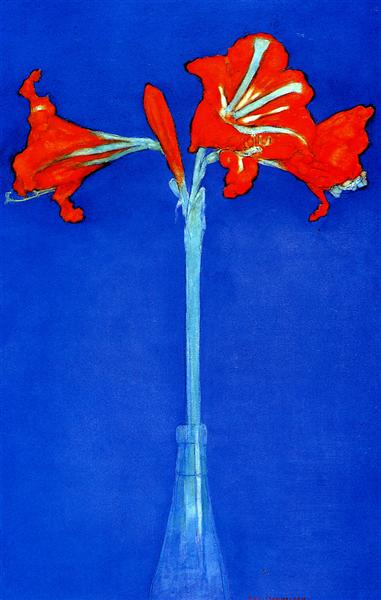Description
The work "Amarilis" by Piet Mondrian, painted in 1910, is a significant representation of the evolution of its artistic style and its thematic exploration. Throughout his career, Mondrian experienced with various artistic currents until he develops his best known style, neoplasticism, characterized by the use of straight lines, geometric shapes and a reduced colored palette. However, "Amarilis" is in a period where the artist was still immersed in the influence of post -impressionism and symbolism, showing a more lyrical and less rigorous approach in his composition.
The painting presents a bouquet of flowers, specifically from Amarilis, which occupies the central space and seems to be arranged in a jar that is unhaking, allowing the spectator to capture the essence of the object without a clear representation. This blurry approach is a distinctive feature of Mondrian's style at this stage, where subtlety and delicacy are combined to create a dialogue between the flower and the space that surrounds it. The work reflects meticulous attention to color, showing us a vibrant palette that includes red, green and yellow tones. These chromatic elections not only configure visual perception, but also evoke emotions and sensations, contributing to the general atmosphere of the piece.
The use of light plays a crucial role in "Amarilis." Mondrian manipulates the luminosity to highlight the elements of nature and its effect on the environment, capturing the fleeting essence of a moment and the delicacy of life itself. Subtle shadows and reflexes contribute to creating a sensation of three -dimensionality, while keeping the focus on simplicity of the floral form. When observing the painting, it can be seen that, despite its naturalistic theme, Mondrian moves away from realism to seek a more abstract and emotional interpretation, which is a precursor to his most radical style in neoplasticism.
It is interesting to note that, in this work, the artist does not try to represent an explicit narrative or a deep meaning. Instead, "Amarilis" arises as a study on the beauty of shape and color, and its ability to transmit sensations. The symbolic character of the flower can be interpreted as an allusion to life and nature itself, thus presenting a link between the organic and the spiritual.
The period in which this work was created, around 1910, is crucial in Mondrian's trajectory. Just after this moment, the artist would move towards a more austere and geometric style, leaving behind the organic shapes and the indulgent use of the color that characterizes "Amarilis". Through this work, Mondrian's transition to abstract art becomes evident, showing his desire to cause emotions through simplification and dematerialization of his objects.
In summary, "Amarilis" is a work that offers a fascinating view on the evolution of Piet Mondrian as an artist, inviting viewers to contemplate not only the object represented, but also the relationship between the shape, color and space that has to harvest the essence of the natural environment. This painting, although located in an earlier phase of his career, is still an outline of the visual language that Mondrian would develop with great mastery in his subsequent works.
KUADROS ©, a famous paint on your wall.
Hand-made oil painting reproductions, with the quality of professional artists and the distinctive seal of KUADROS ©.
Art reproduction service with satisfaction guarantee. If you are not completely satisfied with the replica of your painting, we refund your money 100%.

